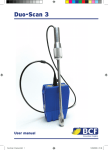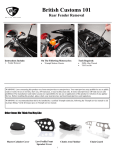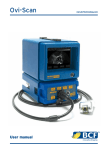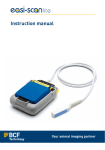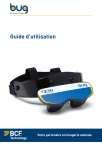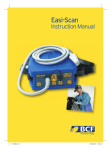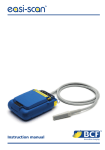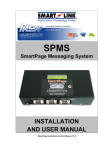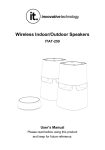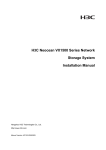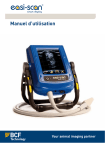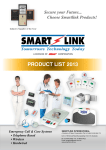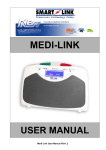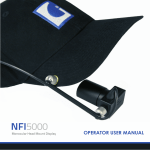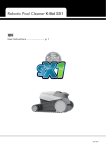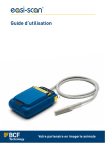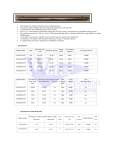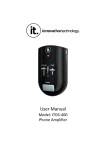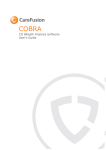Download BUG Manual - BCF Technology
Transcript
Instruction manual Your animal imaging partner BUG versions BUG headband versions Flexi headband 2 Firm headband Contents Introduction page 4 Operator safety 5 1 Operating instructions 5 1.1 Connecting to the scanner 5 1.2 Display positioning 6 1.3 Strap adjustment (flexi headband) 7 1.4 Strap adjustment (firm headband) 7 1.5 Brightness adjustment 7 2 Care and maintenance 8 3 Technical specifications10 Service centres 12 3 Introduction BCF Technology is the market leader in the development and production of “real time” ultrasound pregnancy scanners for large animal species. One of the main benefits of BCF’s scanners is the versatility and ergonomics of our viewing devices. BUG (BCF Universal Goggles) are available in three versions: BUG, LCD BUG and VGA BUG. BCF has utilised the latest OLED technology in BUG to deliver the highest quality image. LCD technology is used in both LCD BUG and VGA BUG. LCD BUG and VGA BUG provide a soft and more familiar image. The BUG devices are designed and manufactured in Scotland at: BCF Technology Ltd 3 Tailend Court, Starlaw Road Livingston, EH54 8TE Scotland, UK T +44 (0)1506 460 023 F +44 (0)1506 460 045 [email protected] www.bcftechnology.com As specialists in providing ultrasound imaging equipment for animal husbandry applications, we understand the importance of using reliable equipment. All BCF products are designed and manufactured to withstand the environments in which they are used. However, should you experience any problems with your BUG, BCF service engineers are available to provide rapid service support and ensure optimum performance of your BCF system. BUG devices have been designed to operate as a component of BCF ultrasound scanners and as such the combined system conforms with the requirements of European Directive 89/336/EEC relating to electromagnetic compatibility (EMC) and also 2002/95/EC relating to Reduction of Hazardous Substances (RoHS). If you require any further information regarding these directives please contact us directly. 4 Note: All BCF Technology products are to be used for animal applications only. Operator safety The BUG devices should only be used for BCF ultrasound scanning systems, and only when scanning animals. Please be aware of your own spatial environment to avoid colliding with unseen objects. Any head mounted viewing device should not be used continuously over a long period of time. Periods of use should not exceed two hours without a break. Mounting the glasses above the line of sight as recommended in this manual will assist your comfort. 1 Operating instructions 1.1 Connecting to scanner BUG goggles are available with two different types of connectors. One is screw type and the other is a push fit. With the screw type, the connector must be screwed tight into the scanner to ensure environmental proofing of the connector and cable. With the push fit, check the cable plug and the scanner socket are clean and free of debris then push the connector firmly into the scanner. 5 TOO CLOSE 1.2 Display positioning Fig 1. Too close The displays are designed to allow you to see the ultrasound image in front of your eyes. This ensures maximum animal awareness whilst ensuring a clear view of the image. TOO CLOSE Fig 1. Too close: head gear is hitting the forehead causing discomfort and limiting adjustment. TOO FAR Fig 2. Too far STRAP ADJUSTMENTS 1 Fig 2. Too far: Distance from eyes is too great causing a less than optimal image. Fig 3. Correct fit (flexi headband only): To test if the housing is too close, place BUG on your head and press unit into your forehead. If the unit is in the correct position, you should only just be able to press the housing onto your forehead. TOO CLOSE 2 TOO FAR Fig. 4 Correct fit (firm headband only): To set the goggles as close as possible to your eyes without the housing touching your forehead, adjust the inner headband angle (position on your forehead) and then pivot the outer band for correct display 1 alignment. STRAP ADJUSTMENTS TOO CLOSE Fig. 5 Raised position 2 (for both headbands): You can move goggles up and down as you would do with sunglasses when not in use. This positioning is useful when you are not scanning. TOO FAR If glasses are normally worn then please continue to use glasses. This position will not be affected by glasses. 6 STRAP ADJUSTMENTS CORRECT FIT Fig 3. Correct fit STRAP ADJUSTMENTS (flexi headband) 1 2 inner headband Fig 4. Correct fit (firm headband) CORRECT FIT Fig 5. Raised position version 1 raised STRAP ADJUSTMENTS 1.3 Strap adjustment (flexi headband) STRAP ADJUSTMENTS Fig 6. The1easiest way to adjust the distance from your eyes is by altering the front two headband tabs. You will have easier access to 2the tabs if you angle the headgear up. Loosening the front headband will cause the housing (and therefore the image) to move closer to your eyes. Tightening the front headband will cause the housing to move away from your eyes. You should do this if the housing is hitting your head. Fig 6. Strap adjustment (flexi headband) STRAP ADJUSTMENTS 1 Fig 7. Securing staps Fig 7. (1) If you are happy with the position of the BUG housing in relation to your eyes, tighten the back two straps so the housing is securely fitted on your head (overlap the straps if needed). (flexi headband) 2 (2) Then lightly tighten the crown strap. 1.4 Strap adjustment (firm headband) Fig 8. Strap adjustment Fig. 8 Once you have obtained a good position for the display, tension the two straps, first adjusting the back strap by sliding the adjuster (1), and then tension the crown strap (2). (firm headband) 1 2 For further video instruction on how to adjust BUG goggles, please visit the “Customer support” section on our website: www.bcftechnology.com 1.5 Brightness adjustment When the BUG devices are connected to the newest model of Easi-Scan, the brightness of the image can be adjusted from the scanner’s setup menu. Refer to the Easi‑Scan user manual for details. This feature is not available when used with Duo-Scan or older versions of Easi-Scan. 7 2 Care and maintenance We have built the BUG display headset to be rugged and splash resistant, however it does contain sensitive electronics and optics. With a little care and maintenance you will enjoy many years of excellent imaging. Care The BUG headset may become damaged if you: • • • Drop it Hose it down Wipe the lenses with your thumb For a long and happy BUG life: • • • • • • 8 Treat the lenses as you would treat your favourite glasses/sunglasses. Clean immediately after use – before any debris dries solid. Disconnect from scanner. Grit / mud should first be removed by rinsing gently – do not rub the lenses. Dry excess water off the housing with a clean soft cloth – do not rub the lenses. Only wipe the lenses with spectacle cleaner fluid and a clean cloth or computer screen wipe – allow to evaporate. Store your BUG in a protective carry case once clean and dry. BUG facts We used plastic lenses to ensure lightweight and achieve desired optical properties of the BUG. They can be replaced at your nearest BCF service centre. The headset housing is splash resistant to withstand use in the rain and gentle rinsing. They will not withstand powerful water jets – i.e. tap full on, hose down or immersion in water. BUG devices are available with two different connector types. The push fit connector is sealed to IP65 and is splash resistant to the same level as the housing. The screw connector is only sealed when properly secured to the scanner but is vulnerable when disconnected. Do not rinse or submerge the connector. Maintenance Replacement forehead pads are available in two different thicknesses. Peel the old pad from the ‘velcro’ on the inner headband and reattach a new one with the absorbent cotton side towards the skin. Your BUG device is sealed. Do not try to take it apart. Return your headset to your authorised BCF service centre or distributor in your country for an annual check, replace seals, elastics and adjust drive circuits for continued high performance. 9 3 Technical specifications BUG specifications Optical lens and display – per eye Pixel resolution: SVGA 800 x 600 Display size: 12.78 x 9 mm Luminance: 850 cd / m2 (white) Contrast ratio: > 300:1 Headset Power consumption: Voltage input: Environmental proofing: Video format: Temperature range: Weight: Compatible with: 700 mW @ 5 V (Easi-Scan 3) or 900 mW @ 6.5 V (Easi-Scan 3 or Duo-Scan) 5.0 V to 6.5 V IP65 NTSC / PAL monochrome – auto detect -40 °C to +40 °C (-40 °F to +131 °F) 300 g Easi-Scan and Duo-Scan LCD BUG specifications Optical lens and display – per eye Pixel resolution: QVGA 320 x 240 Display size: 4.8 x 3.6 mm Luminance: 180 cd / m2 (white) Contrast ratio: 70:1 Headset Power consumption: Voltage input: Environmental proofing: Video format: Temperature range: Weight: Compatible with: 10 600 mW @ 5 V (Easi-Scan 3) or 780 mW @ 6.5 V (Easi-Scan2 or Duo-Scan) 4.8 V to 10 V IP65 NTSC/PAL Monochrome-Auto detect -10 °C to +40 °C (+14 °F to +104 °F) 240 g Easi-Scan and Duo-Scan VGA BUG specifications Optical lens and display – per eye Pixel resolution: VGA 640 x 480 Display size: 9 x 6.8 mm Luminance: 160 cd / m2 (white) Contrast ratio: 80:1 Headset Power consumption: Voltage input: Environmental proofing: Video format: Temperature range: Weight: Compatible with: 1.2 W 4.8 V to 10 V IP65 NTSC/PAL Monochrome-Auto detect -10 °C to +40 °C (+14 °F to +104 °F) 235 g Easi-Scan. Possible to connect to Duo-Scan, older versions of Easi-Scan with adapter leads, with no brightness control. For further information on care and maintenance of the BUG devices please visit the “Customer support” section of the BCF website www.bcftechnology.com 11 Service centres If your Easi-Scan requires servicing please contact official authorised service centres below or distributor in your country. Distributors contact details can be found at www.bcftechnology.com In the UK: BCF Technology Ltd 3 Tailend Court, Starlaw Road Livingston EH54 8TE Scotland, UK T +44 (0)1506 460 023 F +44 (0)1506 460 045 [email protected] www.bcftechnology.com In North America: BCF Technology USA Ltd, LLC 2625 Highway 14 West, Suite K Rochester, Minnesota 55901 T 507-529-8200 T 800-210-9665 F 507-529-8205 [email protected] www.bcftechnology.com In Ireland: BCF Technology Ltd Unit 2, Quayside Business Park Mill Street, Dundalk Co Louth, Ireland T +353 (0)42 932 0070 [email protected] www.bcftechnology.com In Australasia: BCF Ultrasound Australasia Pty Ltd 10/56 Norcal Road Nunawading 3131 Melbourne, Victoria Australia T +61 (0)3 9894 8980 [email protected] www.bcfultrasound.com Your animal imaging partner 12 © BCF Technology Ltd August 2012












